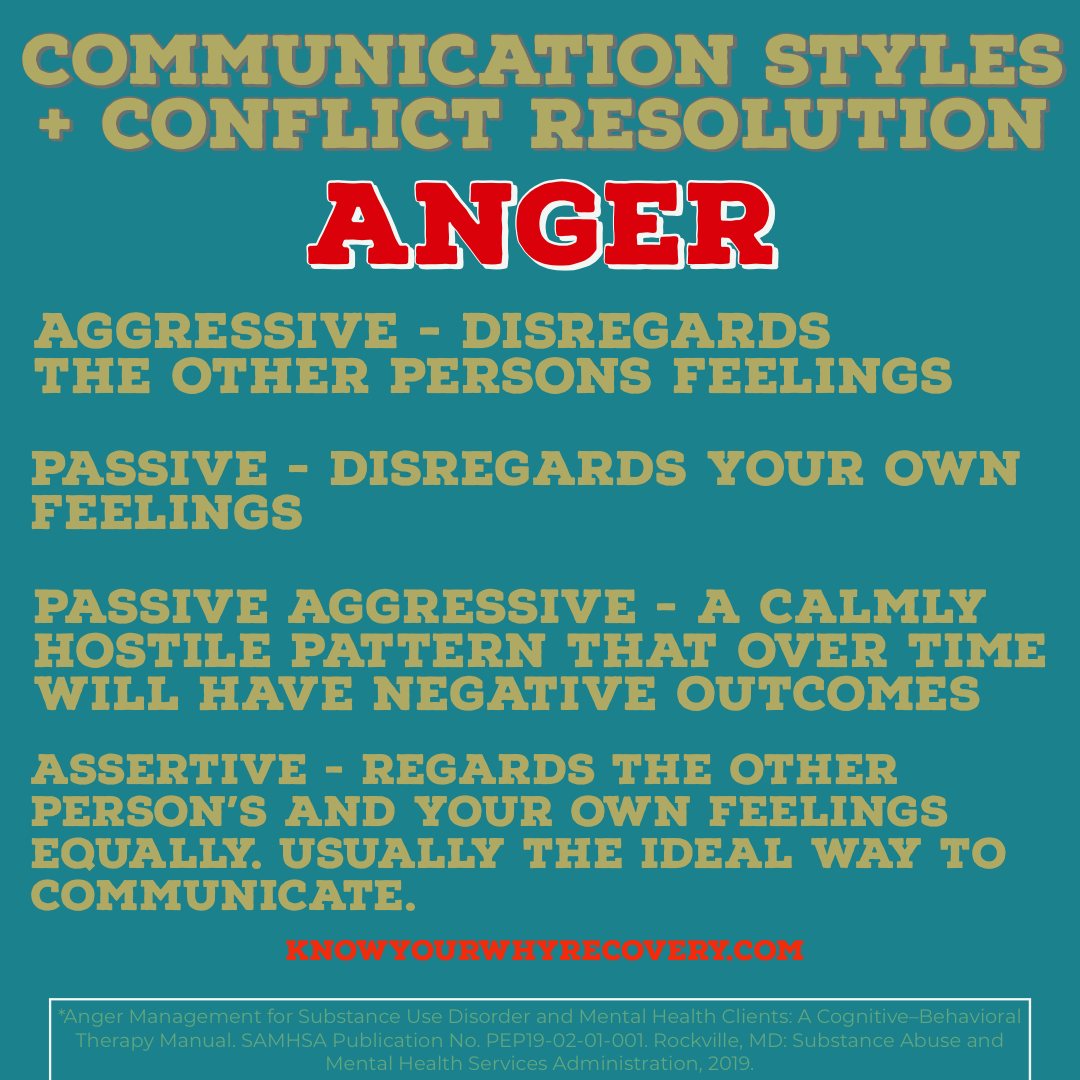
Read below for part 4 in our ongoing series on anger. This installment will focus on assertive communication. Assertive communication is an effective means of communicating our thoughts, feelings, and beliefs. It can assist in conflict prevention and resolution.
Many times, when it comes to an anger provoking or conflict situation, our communication style can make all the difference in not only the possible outcome of the situation, but how we understand and process the situation. Focusing on our communication can help get us out of our emotions and into a calmer mindset. Our responses and communication are learned so if we tend to respond in maladaptive ways or communicate sub-optimally, we can change these behaviors with practice and determination.
There are a few main styles of communication you may or may not have heard of: passive, aggressive, passive-aggressive, and assertive. It is easy to fall into the trap of responding with aggressive communication when we feel wronged or treated unfairly. Aggressive communication tends to put our thoughts, beliefs, and feelings above someone else’s while simultaneously disregarding them. It is equally as easy to feel intimidated in a situation and not communicate effectively or communicate passively in efforts to not seem too aggressive. Passive communication leaves us feeling our thoughts, feelings, and beliefs have been disregarded. Passive-aggressive communication is a form of hostility or, in a way, a rebellion against a person, situation, or demand. This is frequently a response when a demand is placed on someone they may believe is unfair or unjust.
Assertive communication is ultimately the goal in many situations. Assertive communication communicates your thoughts, feeling, beliefs, or needs in a respectful way that does not leave the other person feeling disregarded or attacked since thoughts, feelings, and beliefs were treated equally. You feel more positively because you expressed what you needed to express without causing grief in the other person or feeling left out or walked on yourself.
Let’s look at an example. You are busy at work and already struggling to keep up with assignments. Your boss comes by and drops a stack of papers on your desk and says “I need this completed by the end of the day” and starts to walk out. What does your response look like in the various communication styles?
Aggressive: You shove the papers back toward your boss and say “Find someone else to dump this on or better yet, do it yourself!” You can imagine what type of response from your boss this may cause.
Passive: You agree to the task and spend the rest of the shift ignoring the other work you have to complete so you can finish this. In the end you feel stressed, you are now late with your regular work, and you are upset with yourself for not saying anything or asking for help.
Passive-aggressive: You say nothing or even agree to the task knowing full well you aren’t even going to try. At the end of the day when your boss asks for the work you claim you forgot about it or were unable to get to it. While this might work once or twice, if it is a patterned response, it would obviously reflect negatively on your boss’s perception of your performance.
Assertive: You explain to your boss that you are willing to attempt to complete this assignment and will prioritize it if necessary, but you are already tasked with a number of other assignments and ask for assistance in completing this or for additional deadlines for the other assignments.
In many situations the assertive communication may leave you feeling better about the interaction and may gain a more positive response from the other person involved. You feel heard and respected. You stood up for yourself in a respectable manner. The other person feels as though they also were respected and their needs considered.
It is important to note this is not some magical type of communication. Sometimes you may communicate respectfully, calmly, and assertively but still be met with aggression or not have a situation play out the way in which you hoped. Overall, communicating assertively yields the most consistent positive outcomes over time.
How can you communicate assertively if you are unsure if how you are choosing to communicate is assertive? Try to be respectful and calm. Structure your words using “I” statements. “I” statements are a type of framework for your words that often will assist in making sure your thoughts, feelings, and beliefs are communicated clearly and assertively. “I” statements help cut down on defensiveness They help you keep focus on you rather than on the other person, while simultaneously allowing you to address what you need from the other person (if anything).
A good structure for an “I” statement is “I feel _______, when _______.” You can even add in an “I need______” if appropriate. Using the same example above you could say to your boss “I feel overwhelmed right now when you asked me to do this assignment. I already have a number of assignments I am completing. I need some assistance in completing this or for you to understand some of my normal work may not get completed by day’s end if I prioritize this.”
While “I” statements work well for assertive communication and conflict resolution overall, they are not meant for all situations such as causal interactions, so use your discretion.
Some final thoughts on assertive communication and conflicts. For yourself, be sure to identify specifically what the issue is, how you are feeling, and what the impact of this situation is. Then decide if it is a conflict you have to actually resolve. Not all conflicts deserve resolution or specific attention. If so, then work toward resolution.
-Chris Dorian, founder of Know Your Why Recovery
Based on information on information in Anger Management for Substance Use Disorder and Mental Health Clients: A Cognitive–Behavioral Therapy Manual. SAMHSA Publication No. PEP19-02-01-001. Rockville, MD: Substance Abuse and Mental Health Services Administration, 2019.